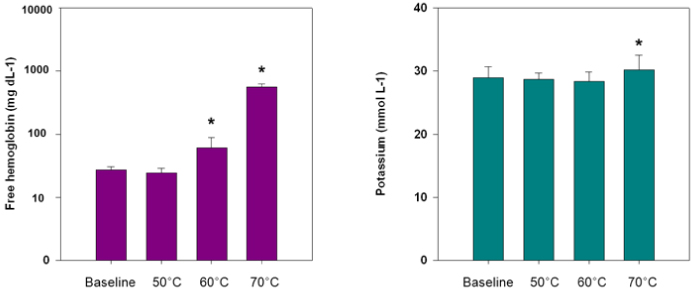J Dent Anesth Pain Med.
2015 Dec;15(4):229-233.
Hemolysis of irradiated leukoreduced red blood cells during rapid warming: An in vitro experimental study
- Affiliations
-
- 1Department of Anesthesiology and Pain Medicine, University of Ulsan College of Medicine, Asan Medical Center, Seoul, Korea. mjgwak@amc.seoul.kr
- 2Department of Laboratory Medicine, University of Ulsan College of Medicine, Asan Medical Center, Seoul, Korea.
Abstract
- BACKGROUND
Although water chambers are often used as surrogate blood-warming devices to facilitate rapid warming of red blood cells (RBCs), these cells may be damaged if overheated. Moreover, filtered and irradiated RBCs may be damaged during the warming process, resulting in excessive hemolysis and extracellular potassium release.
METHODS
Using hand-held syringes, each unit of irradiated and leukocyte-filtered RBCs was rapidly passed through a water chamber set to different temperatures (baseline before blood warming, 50℃, 60℃, and 70℃). The resulting plasma potassium and free hemoglobin levels were then measured.
RESULTS
Warming RBCs to 60℃ and 70℃ induced significant increases in free hemoglobin (median [interquartile ranges] = 60.5 mg/dl [34.9-101.4] and 570.2 mg/dl [115.6-2289.7], respectively). Potassium levels after warming to 70℃ (31.4 ± 7.6 mEq/L) were significantly higher compared with baseline (29.7 ± 7.1 mEq/L; P = 0.029). Potassium levels were significantly correlated with storage duration after warming to 50℃ and 60℃ (r = 0.450 and P = 0.001; r = 0.351 and P = 0.015, respectively).
CONCLUSIONS
Rapid warming of irradiated leukoreduced RBCs to 50℃ may not further increase the extracellular release of hemoglobin or potassium. However, irradiated leukoreduced RBCs that have been in storage for long periods of time and contain higher levels of potassium should be infused with caution.
Keyword
MeSH Terms
Figure
Reference
-
1. Repin NV, Bobrova EN, Repina SV. Thermally induced transformation of mammalian red blood cells during hyperthermia. Bioelectrochemistry. 2008; 73:101–105.
Article2. Roseff SD, Luban NL, Manno CS. Guidelines for assessing appropriateness of pediatric transfusion. Transfusion. 2002; 42:1398–1413.
Article3. Sowemimo-Coker SO. Red blood cell hemolysis during processing. Transfus Med Rev. 2002; 16:46–60.
Article4. Vraets A, Lin Y, Callum JL. Transfusion-associated hyperkalemia. Transfus Med Rev. 2011; 25:184–196.
Article5. Brown KA, Bissonnette B, McIntyre B. Hyperkalaemia during rapid blood transfusion and hypovolaemic cardiac arrest in children. Can J Anaesth. 1990; 37:747–754.
Article6. Ivens D, Camu F. Sudden hyperkalemia during cardiopulmonary bypass with hypothermic cardiac arrest in an infant. J Cardiothorac Vasc Anesth. 1996; 10:258–260.
Article7. Moroff G, Leitman SF, Luban NL. Principles of blood irradiation, dose validation, and quality control. Transfusion. 1997; 37:1084–1092.
Article8. Brugnara C, Churchill WH. Effect of irradiation on red cell cation content and transport. Transfusion. 1992; 32:246–252.
Article9. Zimmermann R, Wintzheimer S, Weisbach V, Strobel J, Zingsem J, Eckstein R. Influence of prestorage leukoreduction and subsequent irradiation on in vitro red blood cell (RBC) storage variables of RBCs in additive solution saline-adenine-glucose- mannitol. Transfusion. 2009; 49:75–80.
Article10. Gammon RR, Strayer SA, Avery NL, Mintz PD. Hemolysis during leukocyte-reduction filtration of stored red blood cells. Ann Clin Lab Sci. 2000; 30:195–199.11. Carson TH, Bloom J, Ferguson DB, Thompson S, LeBeau B. Delayed hemolysis of white cell-reduced red cells. Transfusion. 1994; 34:86.
Article12. Schmidt WF 3rd, Kim HC, Tomassini N, Schwartz E. RBC destruction caused by a micropore blood filter. JAMA. 1982; 248:1629–1632.
Article13. Wagner SJ, Myrup AC. Prestorage leucoreduction improves several in vitro red cell storage parameters following gamma irradiation. Transfus Med. 2006; 16:261–265.
Article14. Eastlund T, Van Duren A, Clay ME. Effect of heat on stored red cells during non-flow conditions in a bloodwarming device. Vox Sang. 1999; 76:216–219.
Article15. Cohn SM, Stack GE. In vitro comparison of heated saline-blood admixture with a heat exchanger for rapid warming of red blood cells. J Trauma. 1993; 35:688–690. discussion 690-81
Article16. Smith HM, Farrow SJ, Ackerman JD, Stubbs JR, Sprung J. Cardiac arrests associated with hyperkalemia during red blood cell transfusion: a case series. Anesth Analg. 2008; 106:1062–1069. table of contents.
Article17. Chen CD, Ko TM, Hsieh FJ, Huang SF. Intrauterine death of co-twin in the third trimester: a case report of twin-to-twin transfusion syndrome and cord accident. J Formos Med Assoc. 1993; 92:665–667.18. Hall TL, Barnes A, Miller JR, Bethencourt DM, Nestor L. Neonatal mortality following transfusion of red cells with high plasma potassium levels. Transfusion. 1993; 33:606–609.
Article19. Vermeulen Windsant IC, Hanssen SJ, Buurman WA, Jacobs MJ. Cardiovascular surgery and organ damage: time to reconsider the role of hemolysis. J Thorac Cardiovasc Surg. 2011; 142:1–11.
Article
- Full Text Links
- Actions
-
Cited
- CITED
-
- Close
- Share
- Similar articles
-
- Acute Hemolysis Caused by Transfusion of Overheated Blood: A case report
- Experimental study in the evaluation of the changes of the blood echogenecity on ultrasonography
- A Clinical Study on Hemolysis during Transfusian of Bank Blood
- Automated Collection of Leukoreduced Double Red Blood Cell Units using an Alyx Apheresis Device
- Hemoglobinuria due to the Use of Frozen Red Blood Cells during Anesthesia


